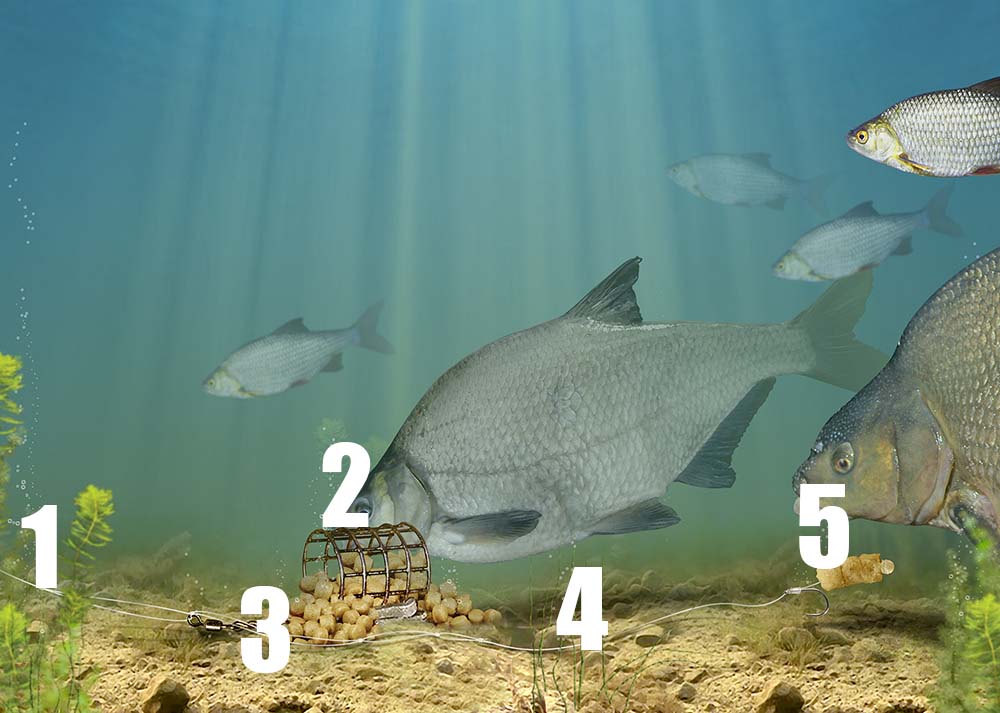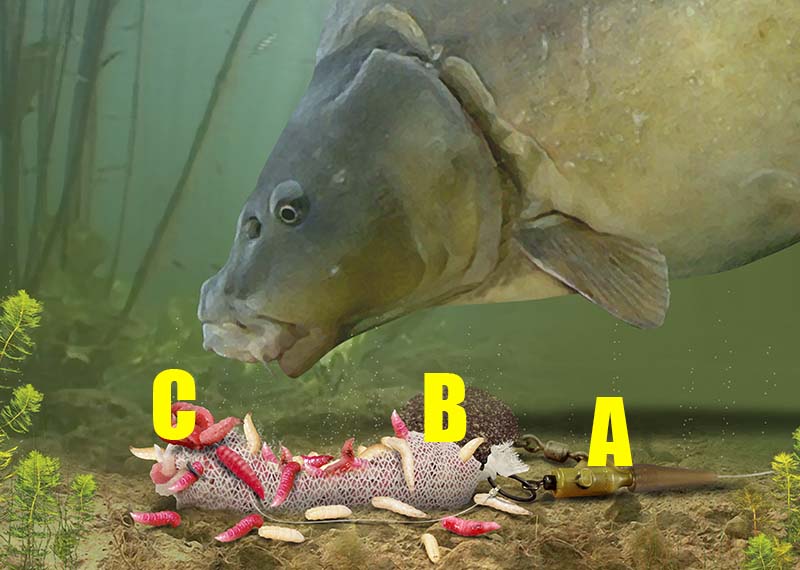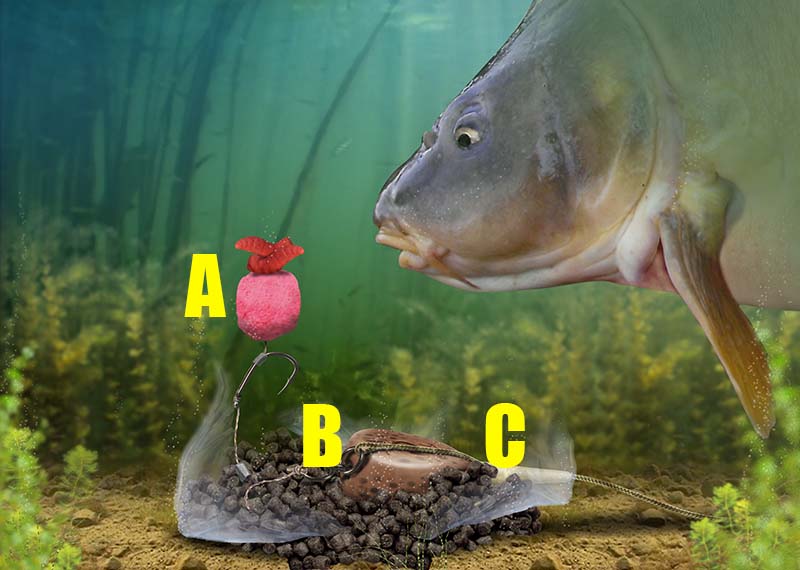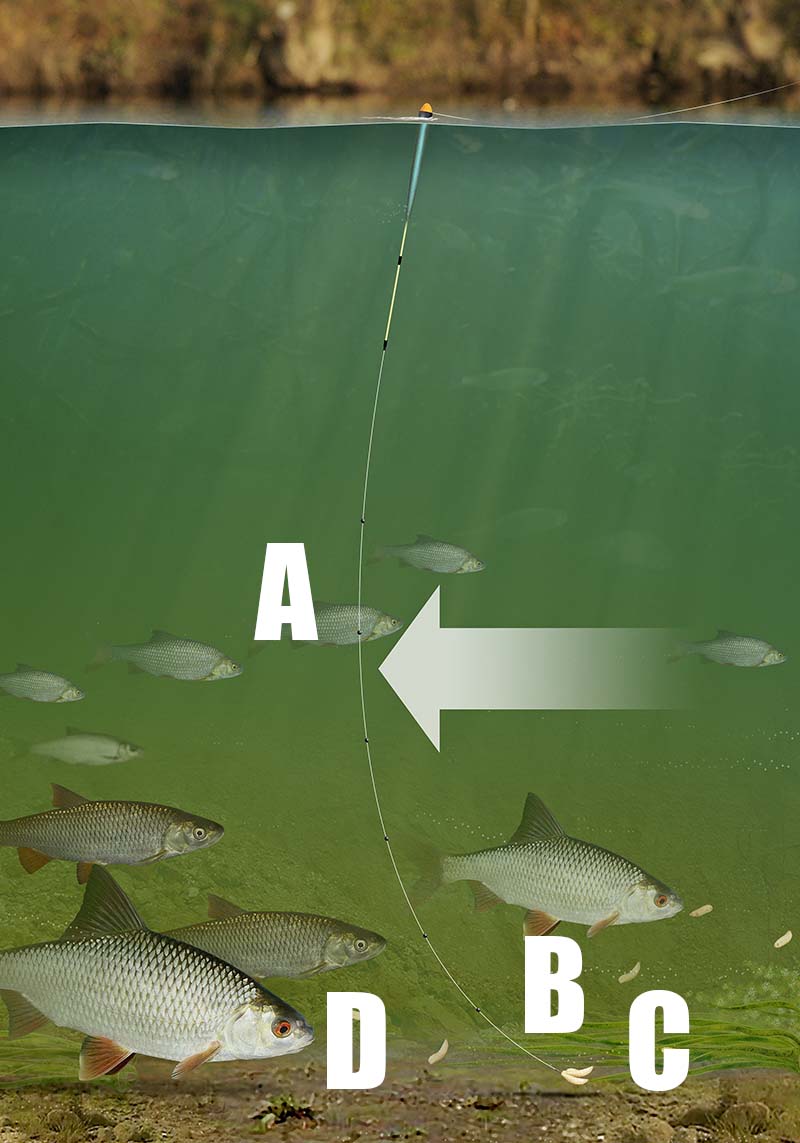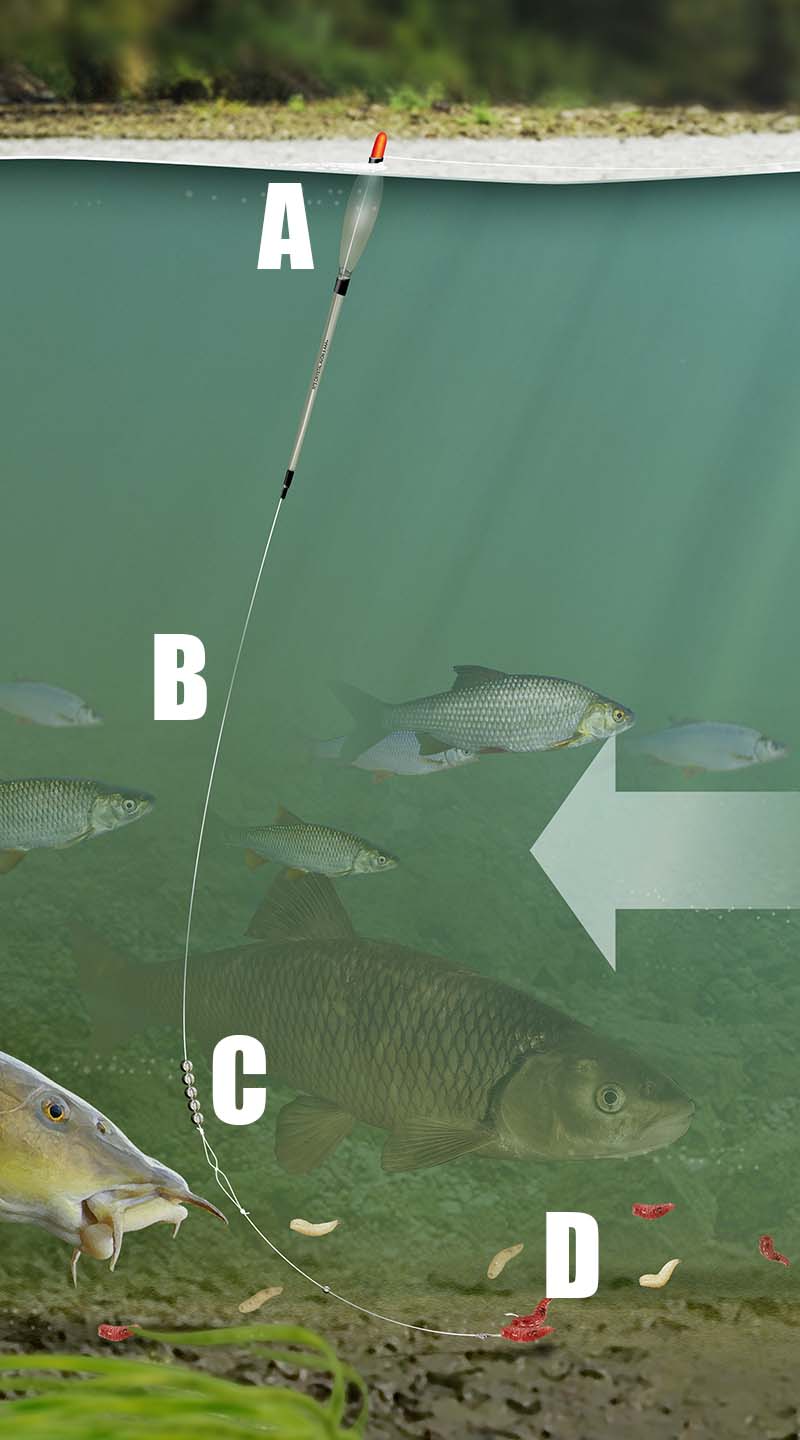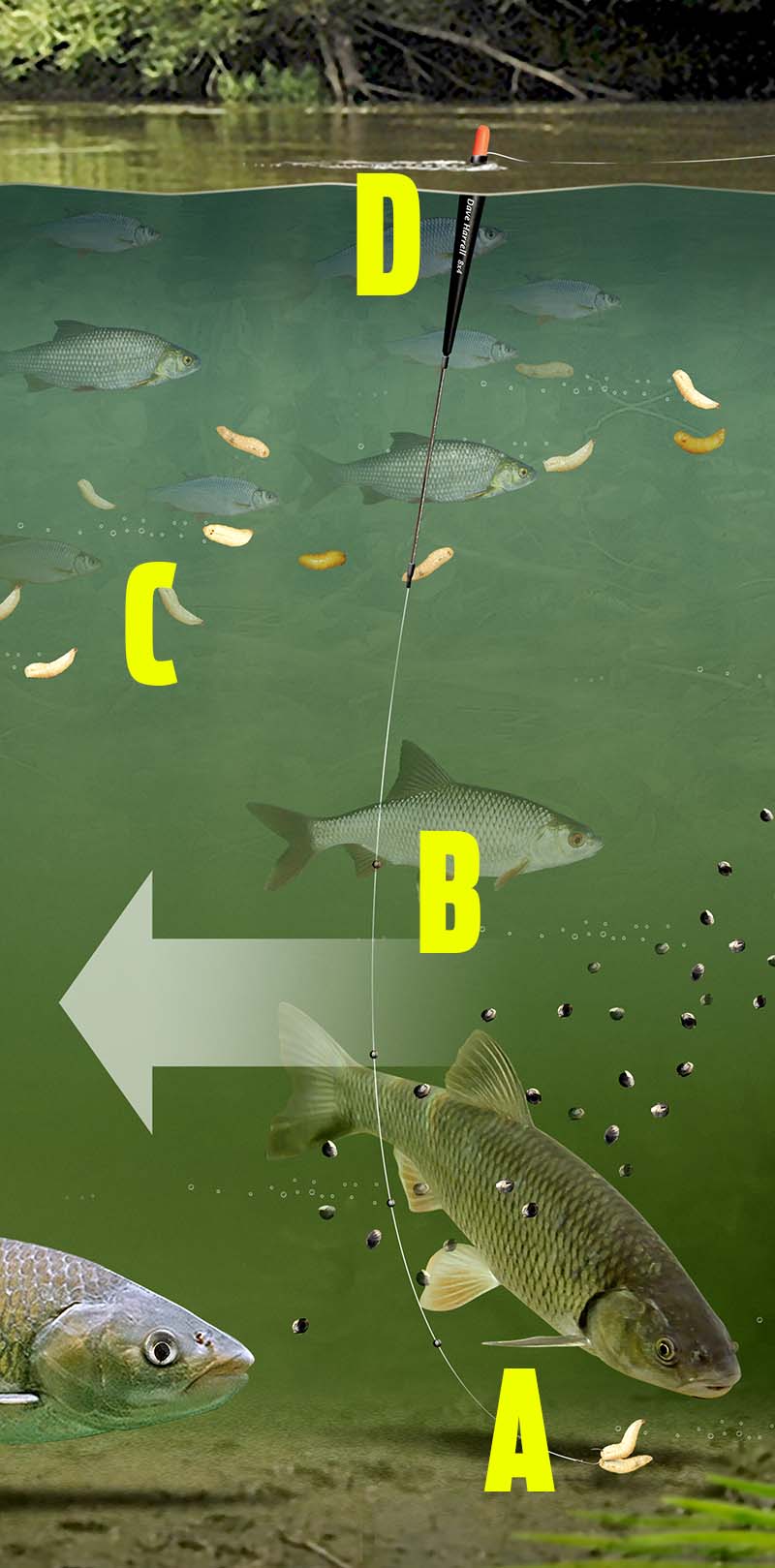Carp fishing rigs | Method feeder
There are a number of different types of rigs that you can use on commercials for carp fishing, and new versions and ideas are appearing all the time, but which one is really the best?
By far and away the most sensible choice is the Method feeder. It allows you to tuck a bait inside a ball of feed and have both mixed together once the feed breaks down in the water.
It’s also a self-hooking rig, meaning there’s no hitting tiny knocks on the quivertip. When a fish is on, you’ll know about it as the rod goes round!
Making the rig is easy, too. Most fisheries insist on your set-up being free-running, but modern tackle means that even elasticated feeders can be used safely.
Guru has its X-Safe system that allows the feeder to pull free of the line in the event of a breakage or the rig becoming snagged.
Elastic acts as a shock-absorber when playing a big carp under the rod-tip, which greatly reduces the number of last-minute hook pulls.
1) Lines and hooks
Big carp can give savage bites on the Method, so don’t skimp on lines. A tough mainline of around 8lb is the order of the day, matched to a 4ins hooklink of low diameter line in a similar breaking strain.
The short hooklink means that the bait will always be close to or in amid the feed. For hooks,
a barbless eyed carp pattern in sizes 16 or 14 will do. The eye is important, as it will allow you to hair-rig baits.
2) Top hookbaits
When a Method load breaks down, you want your hookbait to pop out and be easily visible to the fish, so give them something bright.
A hi-viz orange or yellow mini boilie or wafter, or a brightly-coloured 6mm pellet are good options but often, a plain hard pellet can bring equally good results. Don’t forget dead red maggots or a piece of corn either.
3) What to put around the feeder
Your feed is moulded around the frame of a Method feeder using a special mould, and there are only two choices of feed here – micro pellets or groundbait.
For out-and-out carp fishing, pellets work well. These need to be dampened slightly to help them stick around the feeder. Fishmeal groundbait comes into play when the carp are of a smaller stamp, and normally this is mixed 50/50 with micro pellets.
4) Feeder size
Method feeders range in size from tiny 15g models to massive versions taking over 50g. The size you pick is dependent on how far you need to cast, and any underwater countours.
For long casts, obviously a big feeder will do the job but for short chucks, a much smaller model will do.
Heavy feeders also come into play if you are fishing on an slope running away from an island, the extra weight helps the feeder to grip the lakebed as opposed to sliding down this slope.
5) Safe elastication
If you go down the elasticated feeder route, pick the Guru X-Safe system. This sees heavy pole elastic inside the feeder body stretch when a fish is being played, helping subdue the carp in double-quick time.
Should a fish get snagged and the mainline break, the feeder can pull free to prevent the carp being tethered.
How to tie a method feeder rig for carp fishing
There are a number of different types of feeder to use on commercials for carp in early spring – but which one is really the best?
By far and away the top choice is the Method feeder, allowing you to tuck a bait inside a ball of feed and have both mixed together once the feed breaks down in the water. It’s also a self-hooking rig, meaning there’s no hitting tiny knocks on the quivertip. When a fish is on, you’ll know about it!
Making the rig is easy, too, as most fisheries insist on your set-up being free-running. The feeder is threaded on to the mainline and then stopped by a bead or stop above a short hooklength of around 4ins.
The bait is then buried inside the feed, with the mix moulded around the feeder.
As this feed breaks down quickly once in the water, the bait is exposed and the bite normally isn’t long in coming.
By keeping a tight line between feeder and rod, bites are extremely positive and often result in fish hooking themselves.
A) Feeder weight
A feeder of around 15g to 30g in weight is fine. The only change here would be when fishing on the slope of lakes where the water starts to shallow up leading to the margins, such as you’d find when casting to a far bank or an island. In this situation, a slightly heavier feeder will be needed to grip the slope and stop the feeder rolling down into the deep water.
B) Feeder type
There are a variety of Method feeders available but these can be narrowed down to in-line or elasticated versions, a flatbed being the best shape. This is a perfectly flat feeder that will sit flat on the bottom. Fishery rules often dictate whether elastic can be used. An inline model is safer, and works by having the line running through the body.
C) Hookbait
Any bait will work, but anglers do like to try and use on the hook what they’re putting around the feeder. A banded or soft 6mm pellet is often the number one choice, but in clear water, a brightly coloured 6mm or 8mm mini boilie can produce surprising results.
D) Feed
When it comes to feed you have a choice of groundbait or pellets with the Method. A fishmeal groundbait with a few small 2mm micro pellets dampened down before use is fine, but if you are fishing for just carp, do away with the groundbait and load the feeder up with just micro pellets.
How to tie | The stealth pellet waggler rig
Setting up this pellet waggler rig couldn’t be easier if you think about how to get the best results from the rig that you are using follow our simple and easy steps to helping you tie one of these great pellet waggler rigs
1) Foam wagglers are relatively light so I fish them on 5lb Guru Pulse mainline to get maximum distance on the cast.
2) Purpose-built weighted adaptors for all three sizes of foam waggler mean you don’t have to put shot on light mainline, which could potentially damage it. These adaptors take the float down to the perfect level, and help it sit immediately.
3) A Guru pellet waggler snap link swivel allows me to change the size of waggler quickly and without fuss when the need arises.
4) To keep the waggler in place I use three small line stops. That way I can chop and change the depth without fear of damaging the line.
5) Below this I tie on a size 14 Cralusso Quick Snap Swivel which allows me to quickly change my hooklength while keeping everything neat and free from tangles.
6) For this type of fishing I tie my hooklengths 12ins long and for carp in the 4lb-10lb bracket I will use 0.17mm N-Gauge.
7) The hook will be either a size 16 or 18 super MWG pattern, depending on the size of pellet on the bait band. I’ll start with the rig set around 18ins deep with a view to coming higher in the water as the day progresses. I always prefer to start deeper, because that way I can get a better impression of what’s going on below the surface
How to tie | The rocket feeder carp rig
There are many different ways of catching carp up in the water, but one of the most effective is the Rocket Feeder.
As the name suggests, this is a floating feeder that is open at one end, enabling it to be filled with lightly dampened pellets or groundbait, which should be mixed so that it quickly exits the feeder once cast out.
Unlike other tactics, the Rocket Feeder is ideal for use with larger pellets, such as 8mm baits, enabling the angler to introduce sizable food items – ideal for larger carp. The feeder can also be cast long distances, thanks to its aerodynamic shape, so it’s useful when carp are beyond pellet waggler range.
The shape of the feeder means that it acts as a very effective bolt-rig when a carp takes the bait. In fact, it is essential to use strong line with this tactic to avoid being broken on the take. A minimum of 6lb is recommended.
Set the Rocket Feeder about 4ft above the hook then, as the carp become more accustomed to the stream of bait, move the float stops down so that the hookbait is just 2ft deep.
On heavily stocked carp fisheries the Rocket Feeder is an absolute winner at this time of the year. Get on it now!
Slide a float stop on to the mainline, followed by the Rocket Feeder, and then fix two further float stops to lock it in place
Adjust the float stops to lock the feeder in position. Having two stops below the feeder ensures that it will not move on the cast
The feeder should be locked about 3ft above the end of the mainline
Tie a figure-of-eight knot in the end of the mainline to form a small loop which you will attach the hooklength to
Use a four-turn grinner knot to attach the hook. Use a clear line a this is less visible when fishing up in the water
The hooklength should be 1ft long and attached to the mainline using a loop-to-loop knot. Attach the hookbait using a bait band
Top 5 pole rigs that you need to try!
No matter where you choose to fish this month, you can guarantee that your target species will come close to the bank in search of food now that the temperatures have risen sharply.
When this happens, the pole is an unbeatable item of tackle but the sort of rig you use with it will dictate whether you get just a few bites or have a session that you won’t forget in a hurry.
Paying careful attention to your terminal tackle and bait choices is vital if you want to make the most of your time on the bank, as is getting the subtle details such asshotting and float patterns spot on.
We reveal the five most deadly spring pole rigs that are almost certain to help you and your friends put more fish in the net.
The Worm Rig
GOOD FOR: Putting together big mixed bags of quality bream and tench on stillwaters.
TACKLE: Use a rugby ball-shaped float with 5lb mainline, a 4lb hooklength and size 14 or 16 hook.
HOOKBAIT: Half or a full worm will appeal to both species at this time of year.
The Maggot Rig
GOOD FOR: Quality roach that will only feed if the hookbait looks natural.
TACKLE: Keep it light with 3lb mainline, a 2lb hooklength and a size 18 or 20 hook.
HOOKBAIT: Red maggots will keep the bites coming. Alternate between single and double.
The Pellet Rig
GOOD FOR: Catching F1s and carp in open water swims on commercials.
TACKLE: A narrow float will help you spot every bite. Use 5lb mainline to a 4lb hooklength and a size 16 hook.
HOOKBAIT: Start with a 4mm expander, switching to a banded pellet if small fish show.
The Margin Rig
GOOD FOR: Catching the biggest carp and F1s in the lake, especially late in the session.
TACKLE: Don’t risk getting bust by a big carp and use 6lb mainline to a 5lb hooklength. A strong float with a thick tip is a must.
HOOKBAIT: Corn is unbeatable in the margins.
The Meat Rig
GOOD FOR: Fishing in open water for carp, F1s, big bream and tench on commercials.
TACKLE: A balanced rig helps catch all species. Use 5lb mainline, 4lb hooklength to a size 16 hook.
HOOKBAIT: A 6mm cube of meat will catch all species that are stocked in the fishery.










